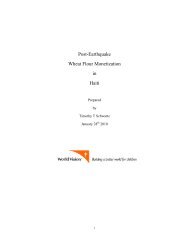Right to Livelihoods in Haiti
Focus on egg production and rural household livelihood strategies
Focus on egg production and rural household livelihood strategies
You also want an ePaper? Increase the reach of your titles
YUMPU automatically turns print PDFs into web optimized ePapers that Google loves.
Eggs <strong>in</strong> 1,000s<br />
4<br />
Table 1: Change <strong>in</strong> Hatchery Capacity vs. Actual Production 1980 - 2012<br />
Year<br />
Number of<br />
hatcheries<br />
Total hatchl<strong>in</strong>g<br />
capacity per month<br />
Hatchl<strong>in</strong>gs produced<br />
per month<br />
Ratio<br />
production/capacity<br />
1980 4 1,000,000 400,000 40%<br />
1990 1 500,000 250,000 50%<br />
2000 1 400,000 40,000 10%<br />
2012 3 558,000 150,000 21%<br />
Source Chatela<strong>in</strong> 2012:21<br />
Urbanization<br />
The decl<strong>in</strong>e <strong>in</strong> agricultural production was not only <strong>in</strong> the <strong>in</strong>dustrial sec<strong>to</strong>r. It occurred <strong>in</strong> the context of a<br />
high rate of urbanization. Dur<strong>in</strong>g the same period that production fell, <strong>Haiti</strong> went from a country where<br />
70% of the population of lived <strong>in</strong> rural areas or villages and produced food for household or local<br />
consumption—such as eggs-- <strong>to</strong> one where 50% of the population is urban and produce little <strong>to</strong> no food<br />
at all. iii<br />
Figure 1: Growth <strong>in</strong> Dom<strong>in</strong>can Egg Production<br />
Year 2002 <strong>to</strong> 2012<br />
2000000<br />
1900000<br />
1800000<br />
1700000<br />
1600000<br />
1500000<br />
1400000<br />
1300000<br />
1200000<br />
1100000<br />
1000000<br />
2004 2005 2006 2007 2008 2009 2010 2011 2012<br />
YEAR<br />
Source: http://www.cei-rd.gov.do/ceird/pdf/direc<strong>to</strong>rio_exportadores/<br />
ESTUDIO_SOBRE_EL_MERCADO_ DE_POLLOS_Y_HUEVOS.pdf<br />
Dom<strong>in</strong>ican Eggs<br />
While <strong>Haiti</strong> was rapidly urbaniz<strong>in</strong>g and the economy was contract<strong>in</strong>g <strong>in</strong> terms of both agriculture and nonfood<br />
production, the economy of <strong>Haiti</strong>’s already heavily urbanized neighbor, the Dom<strong>in</strong>ican Republic, was<br />
experienc<strong>in</strong>g dramatic growth. Between 1991 and 2013 the Dom<strong>in</strong>ican economy grew at an average<br />
annual rate of 5.5%, among the fastest <strong>in</strong> the world. Growth <strong>in</strong> egg production was among the most<br />
vibrant aspects of that growth. Dom<strong>in</strong>ican egg production doubled <strong>in</strong> the years 2004 <strong>to</strong> 2011. A major<br />
outlet for Dom<strong>in</strong>ican production was <strong>Haiti</strong>. In the past 15 years alone the amount of Dom<strong>in</strong>ican products<br />
enter<strong>in</strong>g <strong>Haiti</strong> have <strong>in</strong>creased 20 fold: official <strong>Haiti</strong>-Dom<strong>in</strong>ican cross border trade went from $71.9 million<br />
2001 <strong>to</strong> $802 million <strong>in</strong> 2010. At least 90% of the trade was <strong>in</strong> favor of the Dom<strong>in</strong>icans. S<strong>in</strong>ce the 2010<br />
earthquake trade has doubled aga<strong>in</strong>, reach<strong>in</strong>g an estimated USD $1.5 billion. Only $50 million of the<br />
current <strong>to</strong>tal is <strong>in</strong> favor of <strong>Haiti</strong>. Eggs became one symbol of Dom<strong>in</strong>ican market success and its dom<strong>in</strong>ation
















